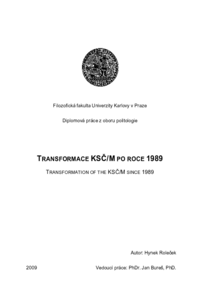Transformace KSČ/M po roce 1989
Transformation of the KSČ/M since 1989
diploma thesis (DEFENDED)

View/
Permanent link
http://hdl.handle.net/20.500.11956/18960Identifiers
Study Information System: 68830
CU Caralogue: 990010957550106986
Collections
- Kvalifikační práce [24155]
Author
Advisor
Referee
Buben, Radek
Faculty / Institute
Faculty of Arts
Discipline
History - Political Science
Department
Institute of Political Science
Date of defense
29. 1. 2009
Publisher
Univerzita Karlova, Filozofická fakultaLanguage
Czech
Grade
Excellent
Proces transformace KSČ a její nástupkyně KSČM po listopadu 1989 je jedinečným příkladem nedokončené přeměny komunistické strany ve stranu nekomunistickou. Jádrem tohoto procesu se stal vývoj KSČ(S) a KSČM v letech 1989-1996. Strana se po změně politického systému zachraňuje v prvních svobodných volbách v roce 1990. Hledá možnosti změny, což vyvrcholí vnitrostranickým referendem z přelomu let 1991-1992, kdy se většina rozhodne pro zachování stávajícího označení. Rozhodujícím bodem celého procesu se stává prostějovský sjezd v červnu 1993, kdy vítězí křídlo, jež se radikální změně brání a stranu konzervuje. I přes silné stranické štěpení, v němž vzniká mnoho nekomunistických stranických subjektů, se strana ve volebním roce 1996 může opřít o pevné voličské jádro. Pro stranu je to signál, že nastoupený trend pozice KSČM nejen upevnil, ale nabídl i další možnosti pro její posílení.
The process of transformation of the Czechoslovak Communist Party (KSČ) and its successor the Communist Party of Bohemia and Moravia (KSČM) since November 1989 is a unique example of incomplete transformation of the communist party into the non-communist party. The core of this process was the development of the KSČ and the KSČM in 1989-1996. The party following a change in the political system saves in the first free elections in 1990. The party searches possibilities of changes, which culminates into internal referendum in 1991- 1992, when the majority decides to keep the original labelling. The decisive point of the whole process is Congress in Prostějov in June 1993 when the winning faction prevents the radical change and preserves the party. Despite the strong party fission, which creates a lot of non-communist parties, the KSČM may rely on the solid core of voters in the elections of 1996. It is a signal for the party that the trend starting by KSČM consolidates positions, even offers other options for strengthening.
